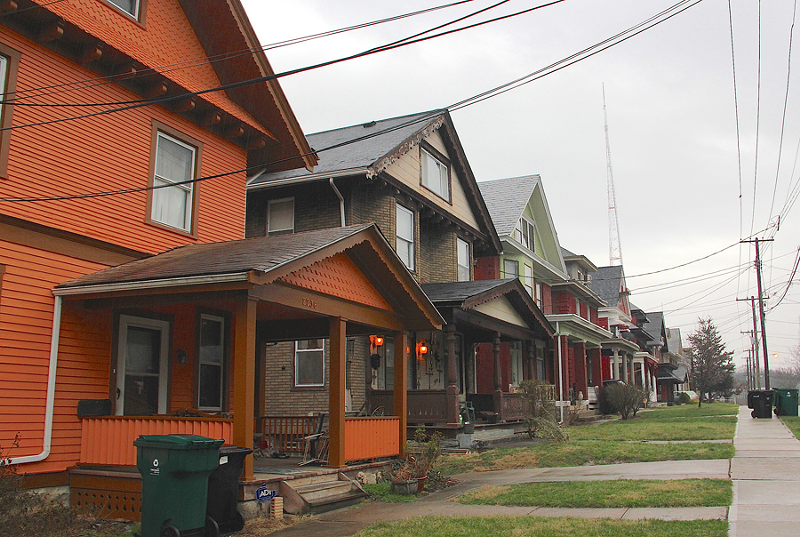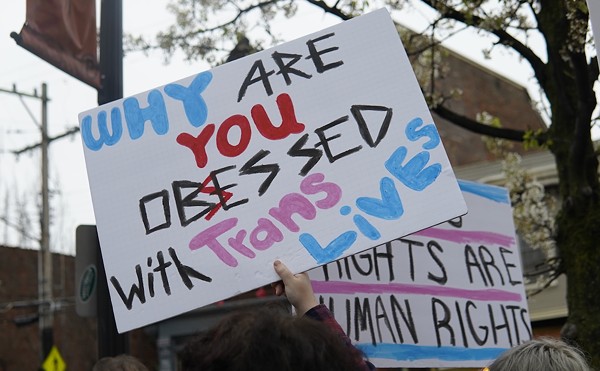
A city program funding cleanup efforts and rehabbing community spaces also has negative consequences for those in some low-income neighborhoods.
Mount Auburn residents say they were deluged with code compliance orders during the Neighborhood Enhancement Program, which undertook a so-called “90-day sweep” of the neighborhood last fall.Those orders can mean serious money on repairs and fines — which double after 90 days — and even jail time if residents don't get the problems fixed eventually.
The increase has stirred deeper tensions around code compliance, socioeconomic status and fears about gentrification in the often-neglected hilltop keystone between the bustling developments in Over-the-Rhine and uptown neighborhoods.
“We’ve experienced this before,” Mount Auburn Community Council President Stanley Broadnax told a group of city officials and residents Feb. 27. “But it may have intensified, because we’re the last undeveloped hillside in the city and the property is valuable. The problem has become so overwhelming that, if we don’t get on top of it, many people who are sitting here are going to end up in a foreclosure court, lose their property or end up in jail.”
In 2016, the year the NEP did its 90-day blitz in Mount Auburn, the city served residents and property owners there with some 1,464 code complaints, according to city records — more than any other neighborhood in Cincinnati. Those included orders issued during the 90-day sweep as well as a number of others issued before or after.
“That’s a lot for a neighborhood this small,” Cincinnati City Councilwoman Yvette Simpson says.
The community of about 5,000 received more orders than Westwood — which has 30,000 people — as well as Avondale and Walnut Hills, larger and similarly low-income neighborhoods.
The Neighborhood Enhancement Program, which has served 22 Cincinnati neighborhoods in the decade since it kicked off in Avondale and Price Hill in 2007, sometimes comes with a swarm of municipal code orders for neighborhood residents for serious structural concerns or minor violations like high weeds, chipped paint or missing siding.
East Price Hill, which hosted the program in 2014, saw its code orders skyrocket to 3,729 that year. It had 2,286 the year before. Last year, it had 1,308.
But other neighborhoods don’t see massive swells in code orders in NEP years. Walnut Hills, which also hosted the NEP in 2014, saw 469 orders issued that year. The year before, it saw 470. Lower Price Hill, which also had the NEP come through last year, saw 514 code compliance orders in 2016. The year before, it had 419. Both neighborhoods have similar vacancy rates and economic profiles to Mount Auburn.
City officials say the goal of the NEP is to improve the neighborhood, not to come down hard on neighborhood residents.
“The intent is to work with the community to improve the quality of life in the neighborhood,” said NEP Coordinator Ethel Cogen, who noted that the Mount Auburn Community Council voted to bring the NEP in. “We have stakeholder meetings four months in advance. The community develops a wish list.”
Cogen highlighted two signature projects the NEP completed in the neighborhood — improvements on Inwood Park and a new health clinic at Taft Elementary School.
Not everyone affected by the code orders lives in Mount Auburn. Art Dahlberg, the city’s director of building and inspections, says landlords, not occupants, own more than 80 percent of the Mount Auburn buildings cited during the NEP.
But other orders went to long-time homeowners like Shannon Carr.
Carr has lived on Burnet Avenue for years, a street where city building and inspections officials issued more than 160 code orders during the NEP. She says she was cited for small, mostly aesthetic issues like paint chipping and missing siding.
Like many homeowners who received notices, she’s suspicious about them — especially at a time when real estate interest in Mount Auburn is heating up as development there begins in earnest.
“It all came around the same time,” Carr says. “Investors starting calling and writing, trying to buy my house, then the NEP came through, then I got these code orders.”
Carr says she can handle the three code orders she got. But others aren’t as certain about their standing.
At a Feb. 27 meeting at Taft Elementary called by Cincinnati City Council members Yvette Simpson, Wendell Young and Chris Seelbach, about 60 people crowded into the school’s small cafeteria to air complaints and try to get questions answered about the NEP and code enforcement more broadly.
Code orders issued during the NEP came directly from city inspectors doing their sweeps of the neighborhood, Dahlberg says, and have a 90-day timeline for compliance, three times the normal length.
Non-NEP complaints, however, can be called in by anyone. That’s caused worries from residents, who feel like they’re being pushed out.
It's not clear whether there is a connection between development in the neighborhood and the swell of code orders Mount Auburn has seen in recent years. But code enforcement in other cities has been conclusively linked to gentrification and the displacement of long-term low-income residents, often minorities. In Columbus' Olde Towne East neighborhood in the 1990s, academics and filmmakers documented the ways in which complaint-driven code compliance efforts put pressures on long-term residents, sometimes resulting in loss of property.
Gentrification in Olde Towne East was preceded by "a surge of active housing code enforcement in the community," academic and filmmaker Linda Goode Bryant wrote about the Columbus neighborhood in a Fordham University law journal. "Anyone who had housing code or zoning violations received a ticket This court was problematic for residents who had lived in the neighborhood for a long time because it was a complaint-driven system."
Due in part to the deep socioeconomic divisions in Cincinnati and many other cities, code enforcement often falls heavily on neighborhoods where many low-income, predominantly black residents live.
Low-income black neighborhoods like Mount Auburn, Avondale, Evanston and others receive hundreds of code violations a year, while similarly-sized, higher income and predominantly white neighborhoods receive far fewer. Hyde Park, for example, a neighborhood of 13,000 people with a median household income of almost $75,000 a year, saw only 169 code orders last year. Mount Lookout, a similarly-sized neighborhood to Mount Auburn, got 111.
Some issues are due to absentee landlords. Other times, the violations fall on property owners least able to pay to fix up their houses themselves. Help is sometimes available for those who can’t afford fixes, but other owners fall through the cracks.
In the worst-case scenarios, problems can escalate to the point where residents and other small-time property owners end up owing thousands of dollars and face foreclosure or even jail time.
That’s what happened to Stanford Poole, a retired Cincinnati firefighter who owns two small rental properties on Rice Street in Mount Auburn. In 2014, the city cited him for siding damage on one of his houses and issues with a porch on another. Court documents reveal Poole went around with the city several times on those properties, eventually getting a year’s probation and a $3,500 fine for failing to comply to code orders. He fixed the siding issue, but never resolved the issue with the porch to the satisfaction of inspectors.
Eventually, a warrant was issued for Poole’s arrest. A Hamilton County Sheriff’s deputy picked the Madisonville resident up on Feb. 14, and he spent the night in jail before posting bond.
Council members like Simpson and Young would like to boost groups like People Working Cooperatively, which helps low-and-moderate-income people with certain home maintenance work. She and other council members also cite a model run by the city of Cleveland, which has a fund set aside to help low-income homeowners meet code compliance requirements.
In the meantime, the council members also pledged to find legislative solutions to the problems revealed by the NEP, including a proposed rollback for owner-occupants on strict new blight mitigation rules passed by City Council last year.
“We were told when we passed that plan that it would only be targeting people who own tons of rental properties throughout the city and wouldn’t be targeting individual owners who have legitimate reasons why they may be in violation,” Seelbach says. “But in practice, it doesn’t seem to be enforced that way.”





